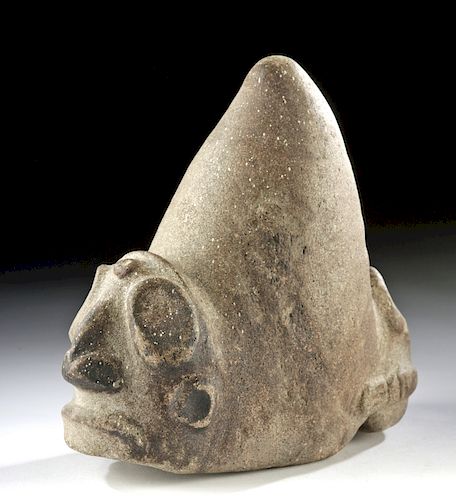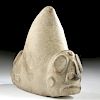Exhibited Taino Stone Trigonolith w/ Crouching Zemi
Lot 52
About Seller
Artemis Fine Arts
686 S Taylor Ave, Ste 106
Louisville, CO 80027
United States
Selling antiquities, ancient and ethnographic art online since 1993, Artemis Gallery specializes in Classical Antiquities (Egyptian, Greek, Roman, Near Eastern), Asian, Pre-Columbian, African / Tribal / Oceanographic art. Our extensive inventory includes pottery, stone, metal, wood, glass and textil...Read more
Estimate:
$7,000 - $9,000
Absentee vs Live bid
Two ways to bid:
- Leave a max absentee bid and the platform will bid on your behalf up to your maximum bid during the live auction.
- Bid live during the auction and your bids will be submitted real-time to the auctioneer.
Bid Increments
| Price | Bid Increment |
|---|---|
| $0 | $25 |
| $300 | $50 |
| $1,000 | $100 |
| $2,000 | $250 |
| $5,000 | $500 |
| $10,000 | $1,000 |
| $20,000 | $2,500 |
| $50,000 | $5,000 |
| $100,000 | $10,000 |
| $200,000 | $20,000 |
About Auction
By Artemis Fine Arts
Oct 3, 2019
Set Reminder
2019-10-03 10:00:00
2019-10-03 10:00:00
America/New_York
Bidsquare
Bidsquare : Exceptional Day 2: Pre-Columbian & Tribal Art
https://www.bidsquare.com/auctions/artemis-gallery/exceptional-day-2-pre-columbian-tribal-art-4453
Day 2 of an important 2-day auction featuring exceptional, museum-worthy examples of Pre-Columbian from the ancient Americas, Native American, African / Tribal, Oceanic, Spanish Colonial and fossils. Artemis Fine Arts info@artemisfinearts.com
Day 2 of an important 2-day auction featuring exceptional, museum-worthy examples of Pre-Columbian from the ancient Americas, Native American, African / Tribal, Oceanic, Spanish Colonial and fossils. Artemis Fine Arts info@artemisfinearts.com
- Lot Description
Pre-Columbian, Hispaniola, Greater Antilles Islands, Taino / Arawak Indians, ca. 1000 to 1500 CE. Among the only items specifically referenced by Spanish chroniclers of the 15th century, a quintessential example of a three-pointed stone (known as a "trigonolith" in English and "trigonolito" in Spanish) with a tall conical point composing the central body, a Zemi face on the front point, and a pair of retracted legs on the verso. The Zemi face is characteristically abstract and presents with wide ovoid eyes, a prominent nose with flared nostrils, thin lips parted in the center, and a circular emblem centered on the forehead. The retracted legs on the verso seem to show the Zemi in a recumbent or crouching position, however scholars posit that their curled portrayal resemble those of frogs. A intricate and fabulous example from ancient Hispaniola! Size: 7.75" L x 3.25" W x 6.4" H (19.7 cm x 8.3 cm x 16.3 cm).
Taino art is comprised of many cult objects associated with the worship of "zemis". The term zemi refers to deities, ancestors, or earth spirits. The Zemi (or Cemi) stone, with its characteristic three cardinal points, is a fundamental symbol in the Taino religion. Tainos traditionally name the three points "Yocahu Bagua Maorocoti" -- another word for the Creator, Yaya. Zemis like this example are believed to be inhabited by powerful spirits. The uppermost point represents the top of this sacred mountain peak, in the turey (sky) of the four directions, where Yaya - the Creator, whose name means that which has neither beginning nor end and which has no male ancestor or creator - resides. The 'chin' point represents Coabey, the underworld or place of the dead. Here Hupia, the spirit of the dead, resides, and the face of Guayaba, the Chief of Coabey, is represented. Finally, the opposite point represents the land of the living where Goiz, the spirit of living people, resides.
For a stylistically-similar example, please see The Centro Leon Museo de Arte, Ecologia e Historia: https://en.centroleon.org.do/cl/colecciones-antropologicas/4315-trigonolito
Provenance: private Hart collection, Houston, Texas, USA; exhibited at the Museum of Native American History (November 2016 - March 2019); ex-private R. Harrison collection; ex-Wilfred Belmar collection, acquired in the 1930s; vetted by Dr. William F. Keegan (Professor of Caribbean studies, University of Florida); papered by Dr. John F. Scott, 2019 Professor Emeritus of Art History, University of Florida
All items legal to buy/sell under U.S. Statute covering cultural patrimony Code 2600, CHAPTER 14, and are guaranteed to be as described or your money back.
A Certificate of Authenticity will accompany all winning bids.
We ship worldwide and handle all shipping in-house for your convenience.
#147522Minor nicks and abrasions to central cone, zemi face, legs, and base, with light softening to some finer details, and light encrustations within some recessed areas, otherwise intact and excellent. Light earthen deposits throughout. Old inventory number written in black ink beneath base.Condition
- Shipping Info
-
All shipping is handled in-house for your convenience. Your invoice from Artemis Gallery will include shipping calculation instructions. If in doubt, please inquire BEFORE bidding for estimated shipping costs for individual items.
-
- Buyer's Premium



 EUR
EUR CAD
CAD AUD
AUD GBP
GBP MXN
MXN HKD
HKD CNY
CNY MYR
MYR SEK
SEK SGD
SGD CHF
CHF THB
THB














